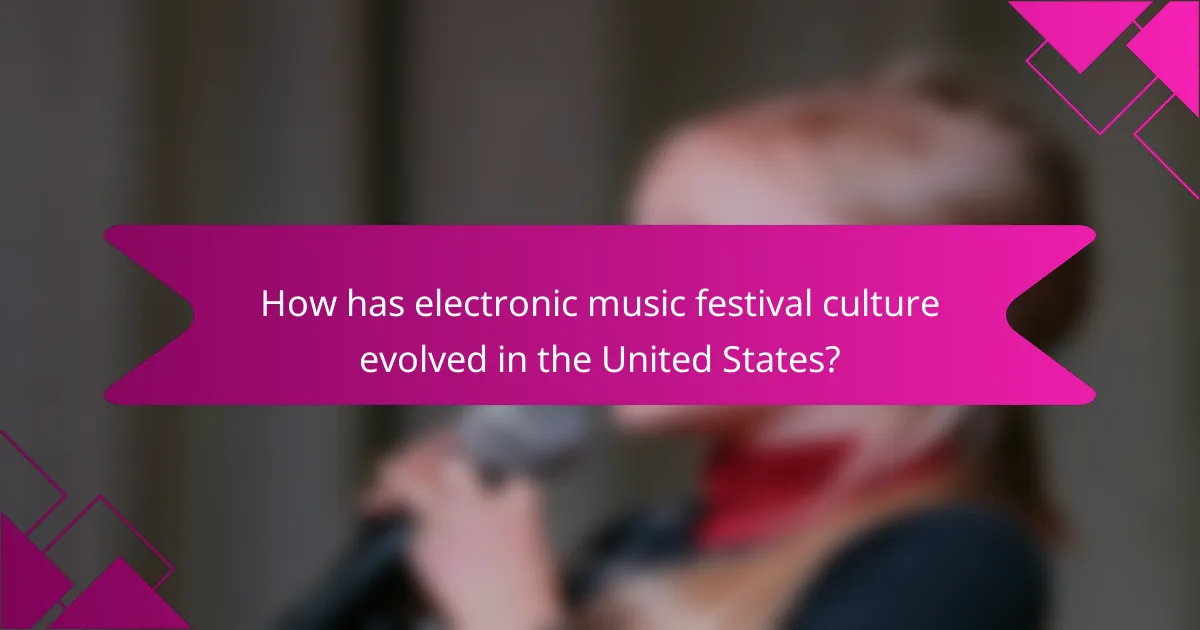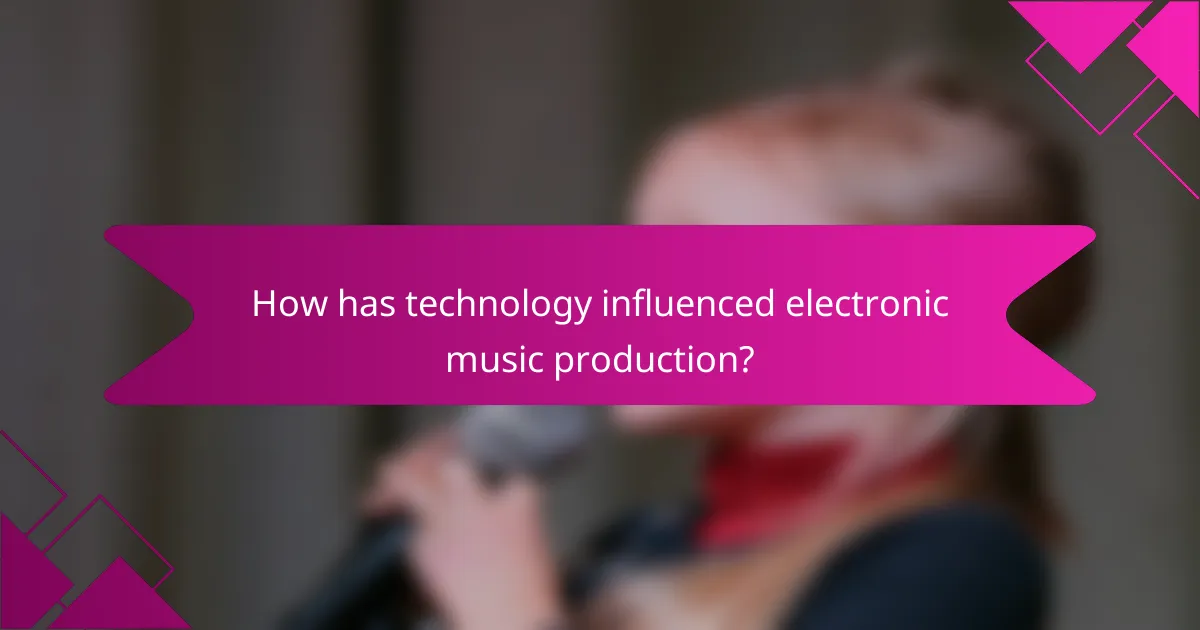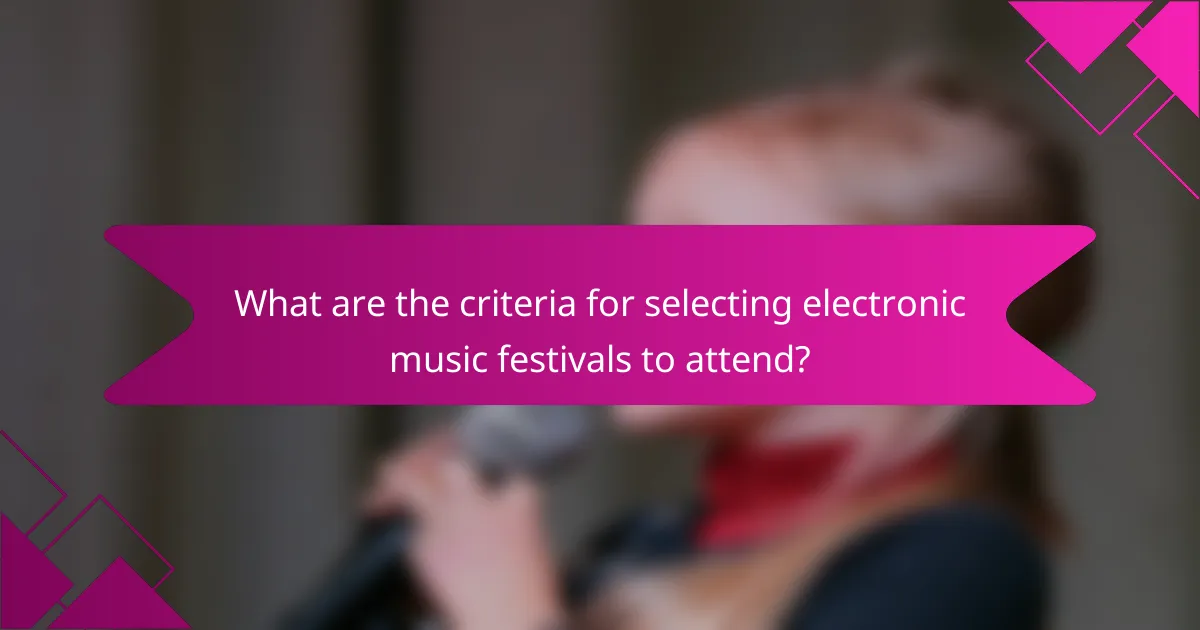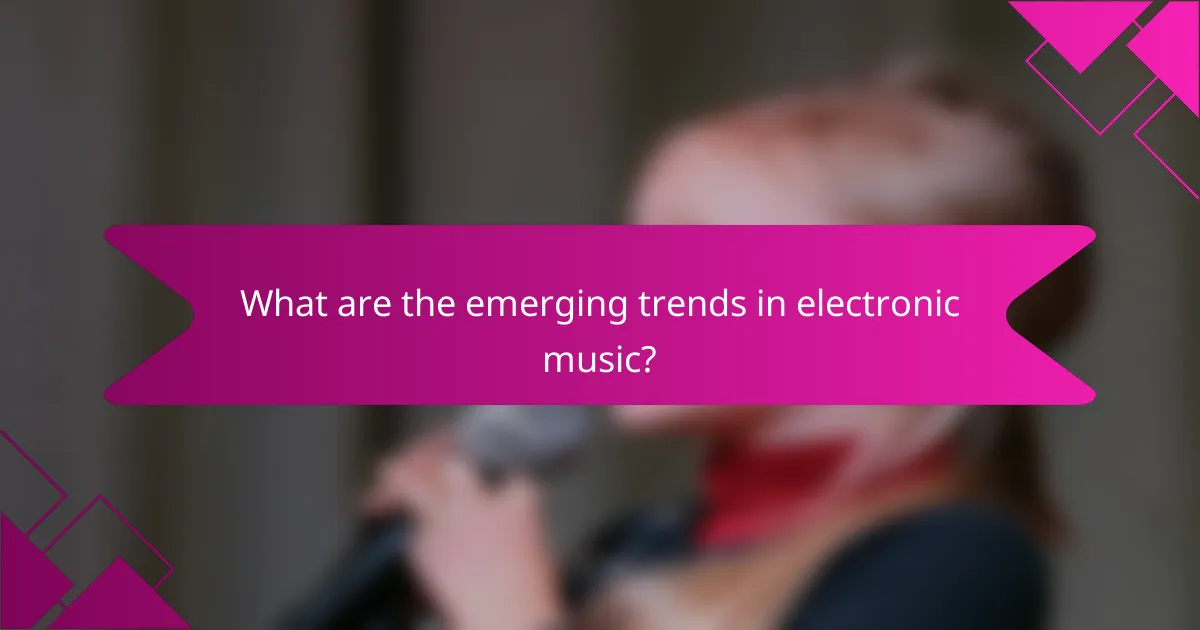Electronic music has become a vibrant cornerstone of festival culture, particularly in the United States, where it has evolved into a significant aspect of youth identity and the music industry. This transformation is driven by the emergence of large-scale festivals and the impact of social media, while key genres like house, techno, and dubstep continue to evolve through technological advancements that enhance music production and accessibility.

How has electronic music festival culture evolved in the United States?
Electronic music festival culture in the United States has significantly transformed over the past few decades, becoming a major aspect of the music industry and youth culture. This evolution is marked by the rise of large-scale festivals, regional events, and the influence of social media in shaping attendees’ experiences.
Growth of major festivals like Coachella
Major festivals such as Coachella have played a pivotal role in the evolution of electronic music culture in the U.S. Since its inception in the late 1990s, Coachella has expanded from a small gathering to a massive event attracting hundreds of thousands of attendees each year. This growth has not only elevated the profile of electronic music but also set trends in festival production, artist lineups, and audience engagement.
Other significant festivals, including Electric Daisy Carnival and Lollapalooza, have followed suit, showcasing a diverse range of electronic genres and drawing international crowds. These festivals often feature elaborate stages, immersive art installations, and cutting-edge technology, enhancing the overall experience for attendees.
Impact of regional festivals on local scenes
Regional festivals have become essential for nurturing local electronic music scenes across the United States. Events like Movement in Detroit and Decadence in Colorado highlight local talent while also attracting national and international artists. This blend fosters a sense of community and encourages collaboration among local musicians and producers.
These festivals often serve as a platform for emerging artists, providing them with exposure and opportunities to connect with fans and industry professionals. As a result, many cities have developed vibrant electronic music cultures that contribute to the overall diversity of the genre.
Role of community and social media in festival culture
Community and social media have transformed how electronic music festivals are experienced and promoted. Platforms like Instagram, TikTok, and Facebook allow fans to share their experiences in real-time, creating a sense of connection and excitement around events. This online engagement often translates to higher attendance and a more vibrant festival atmosphere.
Additionally, social media enables festival organizers to gather feedback, promote lineups, and engage with attendees before, during, and after events. This two-way communication fosters loyalty and encourages fans to participate in the festival culture actively, shaping its future direction.

What are the key genres in electronic music?
The key genres in electronic music include house, techno, dubstep, and trance, each with unique characteristics and cultural significance. These genres have evolved over time, influenced by technological advancements and shifting musical trends.
House music origins and subgenres
House music originated in the early 1980s in Chicago, characterized by its repetitive beats and synthesized melodies. It emerged from disco and was heavily influenced by funk and soul music.
Subgenres of house music include deep house, tech house, and progressive house, each offering distinct sounds and styles. For example, deep house features a more soulful and melodic approach, while tech house blends elements of techno and house for a more minimalistic sound.
Evolution of techno music in Detroit
Techno music emerged in Detroit during the mid-1980s, driven by artists like Juan Atkins, Derrick May, and Kevin Saunderson. This genre is marked by its use of synthesizers, drum machines, and a focus on futuristic themes.
Over the years, techno has diversified into various subgenres, including minimal techno and acid techno. The Detroit sound remains influential, with many festivals and events celebrating its legacy, such as Movement Electronic Music Festival.
Popularity of dubstep and its influence
Dubstep gained prominence in the late 2000s, known for its heavy basslines and syncopated rhythms. Originating from the UK, it quickly became a global phenomenon, impacting mainstream music and festival culture.
Artists like Skrillex and Flux Pavilion helped popularize dubstep, leading to its integration into pop music. The genre’s influence can be seen in various styles, including trap and future bass, showcasing its lasting impact on the electronic music landscape.

How has technology influenced electronic music production?
Technology has profoundly transformed electronic music production by enhancing creativity, accessibility, and efficiency. Innovations in software and hardware allow musicians to produce high-quality tracks from virtually anywhere, democratizing the music-making process.
Advancements in digital audio workstations
Digital audio workstations (DAWs) have revolutionized how music is created and produced. Modern DAWs like Ableton Live, FL Studio, and Logic Pro offer intuitive interfaces and powerful features, enabling artists to record, edit, and mix music seamlessly. These platforms support a wide range of plugins and virtual instruments, allowing for diverse soundscapes.
When choosing a DAW, consider factors such as workflow, compatibility with your operating system, and the specific features you need. Many DAWs offer trial versions, so testing a few can help you find the best fit for your production style.
Impact of synthesizers and samplers
Synthesizers and samplers have been pivotal in shaping electronic music by providing unique sound design capabilities. Synthesizers generate sounds through various methods, such as subtractive synthesis or FM synthesis, allowing for endless sonic possibilities. Samplers, on the other hand, enable artists to manipulate recorded sounds, adding layers and textures to their compositions.
Understanding the different types of synthesizers—analog, digital, and modular—can help you select the right tools for your projects. Experimenting with both synthesizers and samplers can lead to innovative sounds that define your musical identity.
Role of AI in music creation
Artificial intelligence (AI) is increasingly influencing electronic music production by assisting in composition, sound design, and even mastering. AI tools can analyze existing music to generate new melodies, harmonies, or beats, providing inspiration and speeding up the creative process. Some platforms, like Amper Music and AIVA, allow users to create tracks by simply inputting parameters.
While AI can enhance creativity, it’s essential to maintain your unique artistic voice. Use AI as a tool for inspiration rather than a replacement for your creativity, ensuring that your music retains a personal touch. Be mindful of the ethical considerations surrounding AI-generated content, particularly in terms of copyright and originality.

What are the criteria for selecting electronic music festivals to attend?
When selecting electronic music festivals to attend, consider factors such as the diversity of the lineup, the festival’s location and accessibility, and the amenities offered. These criteria can significantly enhance your overall experience and ensure you enjoy the event to its fullest.
Lineup diversity and artist reputation
A diverse lineup featuring a mix of established and emerging artists can greatly enrich your festival experience. Look for festivals that showcase a variety of genres within electronic music, such as techno, house, trance, and drum and bass, to cater to different tastes.
Research the reputation of the artists performing. Festivals with well-known headliners often attract larger crowds, while those featuring up-and-coming talent can provide unique and memorable experiences. Check social media and music platforms for artist reviews and fan feedback.
Location and accessibility considerations
The location of a festival plays a crucial role in your decision-making process. Consider whether the venue is easily reachable by public transport or if it requires a long drive. Festivals in urban settings may offer better access to accommodations and local attractions.
Additionally, evaluate the surrounding infrastructure, such as parking options and nearby amenities. Festivals that provide shuttle services or are located close to hotels can enhance convenience and reduce travel stress.
Festival amenities and experiences
Look for festivals that offer a range of amenities to enhance your comfort and enjoyment. This can include food and beverage options, rest areas, and clean restroom facilities. Festivals that prioritize attendee comfort often create a more enjoyable atmosphere.
Consider the experiences offered beyond the music, such as art installations, workshops, and interactive activities. These elements can add depth to your festival experience, making it more than just a series of performances.

What are the emerging trends in electronic music?
Emerging trends in electronic music include the rise of virtual festivals and the integration of augmented reality in live performances. These trends reflect a shift towards more immersive and accessible experiences for audiences worldwide.
Rise of virtual festivals and online experiences
Virtual festivals have gained popularity, allowing artists to perform live to global audiences without geographical limitations. These online experiences often feature interactive elements, enabling viewers to engage with the performance through chat, polls, and virtual meet-and-greets.
Platforms like Twitch and YouTube have become essential for hosting these events, often attracting thousands of viewers simultaneously. Costs for attendees are typically lower than traditional festivals, making them more accessible, though the experience can lack the physical atmosphere of in-person events.
Integration of augmented reality in performances
Augmented reality (AR) is increasingly being used in electronic music performances to enhance the visual experience. Artists can incorporate AR elements that interact with their music, creating a more engaging and immersive environment for the audience.
For example, AR applications can project visuals that sync with the beat, allowing fans to experience the music in a new dimension. While the technology is still evolving, its potential to transform live shows is significant, offering unique experiences that traditional setups cannot match.
